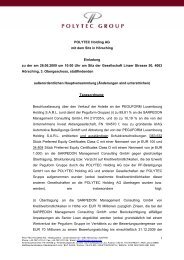A rePort: How is a head- liner actually produced? friedrich ... - polytec
A rePort: How is a head- liner actually produced? friedrich ... - polytec
A rePort: How is a head- liner actually produced? friedrich ... - polytec
You also want an ePaper? Increase the reach of your titles
YUMPU automatically turns print PDFs into web optimized ePapers that Google loves.
7%). If no independent cash fl ow can be allocated to an individual<br />
asset, the value in use of the asset will be calculated by taking into<br />
account the next higher unit of which the asset forms part and for<br />
which the independent cash fl ow can be determined.<br />
Any impairment loss will be d<strong>is</strong>closed with the amount by which<br />
the book value of the individual asset or the cash-generated unit<br />
exceeds the recoverable amount. The recoverable amount <strong>is</strong> the<br />
higher amount of its net selling price and the value in use. Impairment<br />
losses reduce the carrying amount of the assets of the cashgenerating<br />
unit on a pro-rata bas<strong>is</strong>.<br />
If the reason for an extraordinary depreciation ceases to ex<strong>is</strong>t,<br />
write-ups are made in case of tangible assets. Goodwill which<br />
has already been amort<strong>is</strong>ed on account of an impairment are no<br />
longer written up in a subsequent period.<br />
11. Prov<strong>is</strong>ions for Employees<br />
Prov<strong>is</strong>ion for Severance Payments<br />
Based on statutory obligations, employees of Austrian group<br />
companies who joined the company before January 1, 2002, are<br />
entitled to a one-time severance payment upon redundancy or at<br />
retirement. The amount of such severance payment depends on<br />
the number of years of service and the relevant remuneration at<br />
the end of the employment. For all other employees who joined<br />
the company after December 31, 2002, the company pays contributions<br />
to an employee pension fund which are recognized as<br />
an expense.<br />
The prov<strong>is</strong>ions for severance payments are calculated uniformly<br />
on the balance sheet date according to the “projected unit credit<br />
method”, using an interest rate of 4.3% (previous year 4.0%)<br />
and by taking into account an dynamic rate for future increases<br />
of remunerations of 3.0% (previous year: 3.0%). A reduction for<br />
fl uctuation, based on the length of service within the company,<br />
<strong>is</strong> also included in the calculation. The expected pension age<br />
for women and men <strong>is</strong> 62 years tanking into account temporary<br />
arrangements, th<strong>is</strong> pension age has not changed in compar<strong>is</strong>on<br />
to the previous year.<br />
The corridor method <strong>is</strong> used for actuarial gains/losses. If actuarial<br />
gains/losses exceed the present value of the benefi t obligation by<br />
more than 10% at the beginning of the fi nancial year, the actuarial<br />
gains and losses are d<strong>is</strong>tributed over the expected average<br />
remaining working period of employees and recogn<strong>is</strong>ed as income<br />
or expense. Any current service costs, past service costs to be<br />
settled as well as actuarial profi ts and losses are d<strong>is</strong>closed in the<br />
Consolidated Income Statement as part of Personnel expenses.<br />
Interest expenses resulting from severance payments prov<strong>is</strong>ions<br />
are shown under the fi nancial result.<br />
T.F.R. – Entitlement to Severance Payments<br />
Based on legal obligations, employees of Italian group companies<br />
are entitled to receive a one-time payment in case of d<strong>is</strong>m<strong>is</strong>sal<br />
or other legally defi ned events. The amount of such payment<br />
depends on the years of service and the remunerations applicable<br />
at the time of severance.<br />
Prov<strong>is</strong>ions for Pensions<br />
Prov<strong>is</strong>ions for pensions are obligatory for certain employees of<br />
German group companies. Such prov<strong>is</strong>ions for pensions are d<strong>is</strong>closed<br />
in the balance sheet in accordance with IAS 19. For th<strong>is</strong><br />
purpose, the present value of the defi ned benefi t obligation (DBO)<br />
<strong>is</strong> calculated and compared to the current value of the budgeted<br />
assets at the balance sheet date. Prov<strong>is</strong>ions for pensions are calculated<br />
according to the “projected unit credit method”, whereas<br />
depending on the allocation between entitlements and liquid pensions<br />
an interest rate of 4.3% to 4.5% (previous year: 4.25% to<br />
4.5%) and a growth rate of 0.5% to 1.5% (previous year 0.5%<br />
to 1.5%) <strong>is</strong> used. The actuarial calculation refers to the guideline<br />
table 2005G – Klaus Heubeck.<br />
Interest payments resulting from the long-term prov<strong>is</strong>ions for personnel<br />
are reported in the Consolidated Income Statement as part<br />
of the Financial expenses.<br />
Other long-term Liabilities for Employees<br />
Based on the collective agreements or other company agreements,<br />
employees are entitled to receive jubilee payments depending on<br />
their length of service. A prov<strong>is</strong>ion has been accounted for such<br />
payments.<br />
12. Taxes<br />
NOTES<br />
Taxes on income (the tax credit) compr<strong>is</strong>es actual taxes and<br />
deferred taxes.<br />
The actual tax expenditure for each company relates to the taxable<br />
profi t of the company and the applicable tax rate of each<br />
country.<br />
Deferred taxes are calculated, in particular, for value differences<br />
d<strong>is</strong>closed in the tax and commercial balance sheet of the individual<br />
companies resulting from deviating periods, as well as for<br />
consolidation processes. They are computed according to IAS 12<br />
using the balance sheet liability method. Furthermore, the probably<br />
recoverable tax benefi t from ex<strong>is</strong>ting losses carried forward <strong>is</strong><br />
integrated in the calculation. Deferred tax assets on losses carried<br />
forward were formed only when util<strong>is</strong>ation <strong>is</strong> expected within a<br />
foreseeable period. The calculation of the deferred taxes <strong>is</strong> based<br />
on the customary national income tax rate.<br />
13. Other long- and short-term Liabilities<br />
The value of the trade account payables results from the present<br />
value of the received services at the date of their occurrence. Subsequently,<br />
these liabilities are valued at h<strong>is</strong>torical costs.<br />
Other liabilities are reported with their redemption amount.<br />
59<br />
POLYTEC<br />
ANNUAL REPORT 2006

















